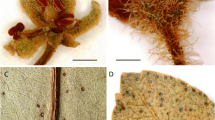Abstract
Gnetum L. is a genus of economic importance distributed in the humid rainforests of Central Africa. The African species of Gnetum are dioecious climbers and only two species (Gnetum africanum Welw. and G. buchholzianum Engl.) have been described previously. The names G. africanum and G. buchholzianum have been applied interchangeably to similar morphological forms of Gnetum specimens in Africa or on duplicates of specimens causing taxonomic confusion. The nomenclature of Gnetum species in Africa is thus in need of reappraisal. Morphological descriptions are based on examination of over 300 specimens from various herbaria, mainly B, BR, FHI, J, K, LISC, P, PRE, WAG and YA. The original applications of the names Gnetum africanum and Gnetum buchholzianum are clarified and two new African species (Gnetum interruptum E.H. Biye sp. nov. and Gnetum latispicum E.H. Biye sp. nov.) are described on the basis of morphological features. A key to the African species is provided and the main characters, such as the shape and size of spike that are essential in the recognition of species in the genus Gnetum in Africa as well as the importance of conservation are discussed. These species are assessed as threatened and at a high risk of global extinction according to the IUCN Red List categories and criteria, and are in need of conservation measures for their protection.






Similar content being viewed by others
References
Biye EH (2013) Sustaining Gnetum L. in Africa through improved taxonomy and domestication. Unpublished PhD thesis, University of Witwatersrand, South Africa
Carlquist S (1996) Wood, bark and stem anatomy of new world species of Gnetum. Bot J Linn Soc 120:1–19
Carlquist S, Robinson AA (1995) Wood and bark anatomy of the African species of Gnetum. Bot J Linn Soc 118:123–137
Clark L, Asaha S, Ndam N, Blackmore P (2004) The key non timber forest products of Central Africa: state of knowledge. Technical paper no. 122:37–59
Earle J (2001) Gnetaceae and Gnetum description. Gymnosperm Database Available from http://www.conifers.org (Accessed 15 Apr. 2008)
Engler A (1908) Gnetaceae africanae. Botanische Jahrbücher für Systematik, Pflanzengeschichte and Pflanzengeographie 40:519–520
Fu L, Yu Y, Michael GG (1999) Gnetaceae. Flora China 4:102–105
Hance J (2009) Smithsonian’s symposium tackles big question: how many species will survive our generation. Available from http://news.mongobay.com/2009/0116-hance-symposium.html [Accessed 11 Oct 2009]
Holmgren PK, Holmgren NI, Barnett LC (1990) Index herbarium, the herbaria of the world. In: Regnum Vegetabile, vol 120, 8th edn. New York Botanical Garden, New York
Hutchinson J, Dalziel JM (1954) Flora of West Tropical Africa, vol 1, part 1. Crown Agents for overseas Government and Administration, London
Isong EU, Adewusi SAR, Nkanga EU, Umoh EE, Offiong EE (1999) Nutritional and phytogeriatological studies of three varieties of Gnetum africanum (‘afang’). Food Chem 64:489–493
IUCN (2012) IUCN Red List Categories and Criteria. 2nd edn Version 3.1. IUCN Species Survival Commission. IUCN, Gland
Jauregui D, Benitez De Rojas C (2005) Morphological aspects and leaf anatomy of the species of Gnetum L. (Gnetaceae-Gnetophyta) present in Venezuela. Acta Botanica Venezuela 28:349–368
Jeffrey C (1977) Biological Nomenclature. Edward Arnold, London
Maheshwari P, Vasil V (1964) Gnetum. Botanical monograph, no. 1. Q Rev Biol 39:142
Onguene NA, Kuyper TW (2001) Mycorrhizal association in the rain forest of South Cameroon. For Ecol Manage 140(2):277–287
Radford AE, Dickison WC, Massey JR, Bell CR (1974) Vascular Plant Systematics. New York, Harper & Row Publishers Inc
Shiembo PN (1999) The sustainability of eru (Gnetum africanum and Gnetum buchholzianum): over-exploited non-wood forest product from the forests of Central Africa. In: Sunderland TCH, Clark LE, Vantomme P (eds) FAO (2001) Current research issues and prospects for conservation and development. Italy, Rome, pp 61–66
Welwitsch F (1858) Ordo Gnetaceae. Sertum Angolense 27:73–74
Won H, Renner SS (2003) Horizontal gene transfer from flowering plants to Gnetum. Proc Natl Acad Sci USA 100:10824–10829
Won H, Renner SS (2006) Dating dispersal and radiation in the gymnosperm Gnetum (Gnetales)–clock calibration when outgroup relationships are uncertain. Syst Biol 55(4):610–622
Acknowledgments
The authors are grateful to the curators of the cited herbaria and to partners of Aluka initiative (http://www.aluka.org) for access to specimens and/or digital images of types, to Donald McCallum and anonymous reviewers for valuable suggestions that improved this paper and to Lesley Deysel for illustrations of the four species of Gnetum in Africa.
Author information
Authors and Affiliations
Corresponding author
Rights and permissions
About this article
Cite this article
Biye, E.H., Balkwill, K. & Cron, G.V. A clarification of Gnetum L. (Gnetaceae) in Africa and the description of two new species. Plant Syst Evol 300, 263–272 (2014). https://doi.org/10.1007/s00606-013-0879-6
Received:
Accepted:
Published:
Issue Date:
DOI: https://doi.org/10.1007/s00606-013-0879-6




